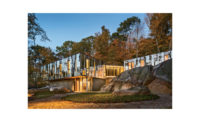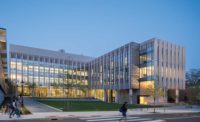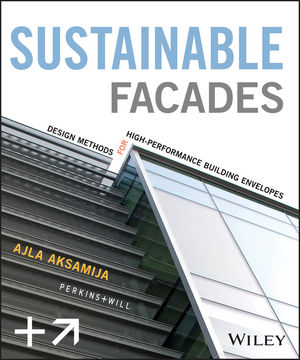High Horse Ranch, in Mendocino County, California, has abundant wildlife—deer, bobcats, chorus frogs, juncos, and more—but nothing equine. Echoing the names of such nearby places as Dead Horse Canyon, this mountainous 64-acre property playfully honors owner Clive McCarthy, who, as his wife, Tricia Bell, puts it, “enjoys getting on his high horse, now and then, for a good-natured rant.” It’s also a nod to the land’s former use: as a marijuana farm. But no longer committed to such crops, the property is now a retreat for this couple and their guests—a remote getaway designed for comfort and an intimate experience with wild terrain in dramatic surroundings.
Additional Content:
Jump to credits & specifications
The pair first came here looking to create an escape from San Francisco, 150 miles to the south, where they inhabit a converted industrial warehouse. They welcomed the idea of getting above the Northern California fog, on a site that reaches an elevation of 2,300 feet. After driving up switchbacks on a gravel road—through steep, mossy terrain, amid soaring firs and craggy oaks draped in lacy lichen—they’d barely entered the property when they caught an unexpected glimpse of a spectacular mountain cleft beneath them; they were smitten. As Bell, then a practicing physician, recalls, “Right then, we both knew we wanted to buy the place.”
They considered local architects before encountering a book by Philadelphia-based KieranTimberlake on Loblolly, a house fabricated off-site. “I loved the precision,” says McCarthy, a British-born former electrical engineer turned tech executive, who now makes digitally inspired artworks. He and Bell were impressed that Loblolly had been assembled (rather than built) without even a chainsaw on-site. They too hoped to tread lightly, preserving the abundant trees on their nearly pristine land.
Soon KieranTimberlake partner James Timberlake visited the property. As he recalls, “It was a once-in-a-lifetime site, and we all hit it off.” Apart from Loblolly, designed by partner Stephen Kieran for his own family, and the temporary Cellophane House in a parking lot at MoMA, the firm hadn’t tried other off-site residential fabrication, much less for a “real” client in a challenging spot.
The couple envisioned a mountaintop house with a seemingly casual, yet orchestrated, approach. The quarter-mile ascent on their grounds would offer that teasing initial peek into the valley before meandering back through dense forest. Then, all cars would park 200 feet downslope from the house in a well-hidden area (doubling as the obligatory fire truck turnaround). Everyone would walk the last stretch or ride in a motorized cart. “Finally, finally, you’d enter the house from its more solid [northwest] side and—blammo!” says McCarthy. A long, southeast-facing wall, mostly of glass, would reveal a phenomenal mountain view, akin to the original glimpse but much more revealing and dramatic.
The narrative also drew on the couple’s experience at Post Ranch Inn, in Big Sur, with its balance between totally private cabins—each nestled in the landscape yet open to a sublime panorama—and a main building, where guests gather over food and drink. Bell and McCarthy wanted a home that would be as comfortable for the two of them alone as it would feel with visitors.
The architects responded with a 2,580-square-foot main residence and two secluded 290-square-foot cabins, all sharing common traits. Rectangular, flat-roofed forms, partially constructed off-site in 12-foot modules, they all play Cor-Ten-clad elevations against a view-framing back wall of floor-to-ceiling, operable glass. The main house consists of two single-story volumes, offset in plan but joined by a service-circulation spine. There, the prime entry crosses into the “great room.” Beneath 11-foot ceilings clad in reclaimed Douglas fir, this dining/kitchen/living area spills out, through pivoting glass doors, onto a terrace. A deep roof overhang and sandblasted-limestone floors (radiant-heated indoors) extend from inside. With doors and windows open, air flows from the glass elevation through a clerestory opposite it. Offering unobstructed sight lines, this 53-foot-long space has large-scale artwork anchoring its ends and an open kitchen with paired work islands, faced in a black paper-resin composite. Giving the interior’s almost-Miesian geometry a slightly rustic twist, exposed Douglas fir structural members mark the rhythm of the house’s 13 modules, which were roughed out off-site, craned onto concrete foundations, and bolted together.
The building’s more private volume contains a study and the master suite, where corner-joined glass walls immerse the bedroom, pavilion-like, in a forest of mossy boulders amid the trees. On a recent visit, the spring weather shifted from misty rain—bringing out mushrooms and the scents of pine needles and wet earth—to a picturesque dusting of snow.
Like the main residence, the elegantly simple cabins have facades textured by expanded Cor-Ten rainscreens and exterior built-ins stacked with firewood. But, unlike the firmly grounded house, these satellites perch on concrete piers over steep terrain. Inside, against a reclaimed-redwood floor and ceiling, each cottage has a bedroom, study area, bathroom, and an entire wall that slides open to the landscape. The cabins, each a single shipping-container-like module, were craned in over the trees, “barely breaking a twig,” recalls Bell. “It’s where the project,” says Timberlake, “best realizes the potential of off-site fabrication.”
The owners had gravitated toward that process for such advantages as swiftness and efficiency. But, on this remote mountain with rudimentary roads and limited regional personnel, the method fell short of expectation. While the trees emerged unscathed, prefabrication is only as good as the contractors who construct the modules and stage their on-site assembly—and that team missed the mark, year after year losing the narrow opportunity to build in a climate with long rainy seasons. Fortunately, the local contractor, who took over once the basic structure and volumes were finally in place, completed the project with skill and finesse, and more traditional means. (The San Francisco–based owners rode out the delays spending weekends in a converted farm outbuilding, elsewhere on the property.)
The final results did not disappoint. “I was over the moon!” says Bell. “We couldn’t believe how great it was to sleep there and be in those spaces, looking into that incredible landscape.” Even from indoors, the couple takes in star-filled skies and the chorus of birds and frogs. “Now, two years later,” she adds, “the delight doesn’t end.”
CreditsArchitect: KieranTimberlake — James Timberlake, design partner; Johann Mordhorst, principal in charge; Andrew Cronin, Kate Czembor, Andrew Schlatter, Jon McCandlish, Shawn Protz, team
Consultant: Sean O’Connor Lighting
Engineers: CVM (structural); Engineering 350 (m/e); Adobe Associates (civil)
General contractor: Buckeye Construction, Moderna Homes |
SpecificationsStructural System Glulam columns and beams: Riddle Laminators
Exterior Cladding Weather barrier: Henry Company Weathering steel expanded metal rainscreen (material): Niles Expanded Metals Custom rainscreen fabrication and installation: Custom Copper Sheet Metal and Roofing
Roofing PVC roofing: Sarnafil
Windows Aluminum windows: Fleetwood
Glazing Glass: Guardian Sunguard SN68 Skylights: VELUX
Doors Aluminum hinged, pivot, and sliding doors: Fleetwood
Hardware Locksets: Assa Abloy Pulls: Halliday Baillie, Krownlab
Interior Finishes Cabinets: Bartlett Cabinet front material: Richlite Paints and stains: Penofin Paneling: Bartlett Solid surfacing: Dupont Corian Stone flooring: Vermont Structural Slate Reclaimed wood flooring and ceilings: North Cal
Lighting Downlights: USAI Lighting Exterior: USAI Lighting Lighting controls: Lutron
Plumbing Toilets: Duravit Lavatories: Duravit Shower trays: Duravit Floor drains: Proline, Kohler, Zurn Bathroom faucets, showerheads, and controls: Hansgrohe Kitchen sinks: Kohler Kitchen faucets: Dornbracht
Energy Radiant heating: Uponor Solar thermal collector: Solar Skies |

















